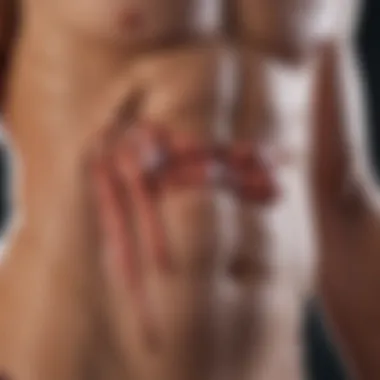Understanding Steroid Myopathy: Insights and Management


Intro
Steroid myopathy represents a significant and often overlooked complication arising from corticosteroid therapy. This condition is characterized primarily by muscle weakness and atrophy, stemming from prolonged exposure to these pharmacological agents. With increased use of corticosteroids in various clinical settings, awareness of this issue becomes paramount for healthcare practitioners.
In this article, we will explore the underlying mechanisms associated with steroid myopathy, examine its implications for patient management, and highlight strategies for detection and intervention. Understanding these facets is crucial, not only for medical professionals but also for individuals undergoing corticosteroid treatment, as early recognition and strategic management can mitigate adverse effects.
Recent Advances
Latest Discoveries
Recent studies have shed light on the biochemical pathways affected by corticosteroids, revealing how they lead to muscle degeneration. Research indicates that corticosteroids interfere with protein synthesis and promote muscle degradation, particularly affecting Type II muscle fibers. These findings underscore the need for clinicians to be vigilant when prescribing corticosteroids, especially over long durations.
Technological Innovations
Innovations in imaging technology, such as magnetic resonance imaging (MRI), have improved the ability to assess muscle condition. MRI can help evaluate changes in muscle morphology and assist in diagnosing steroid myopathy in patients. Enhanced diagnostic tools can lead to more targeted interventions, potentially reducing the long-term impact of steroid usage.
Implications of Steroid Myopathy
Steroid myopathy has profound implications for patient quality of life. Weakness, especially in proximal muscle groups, can significantly affect mobility and independence. This condition may lead to increased risk of falls and disabilities, affecting both physical health and psychological well-being.
Moreover, understanding this condition presents challenges not just for patients but also for healthcare providers. They must balance the therapeutic benefits of corticosteroid use against the risks of developing myopathy. Thus, proper education and support systems become essential for individuals receiving steroid treatment.
Management Strategies
Early Detection and Monitoring
Recognizing the early signs of steroid myopathy is crucial. Healthcare providers should regularly assess muscle strength and function in patients on long-term corticosteroids. Monitoring can involve simple strength tests and patient-reported outcomes, ensuring timely intervention if deficits are identified.
Therapeutic Approaches
Management of steroid myopathy requires a multi-faceted approach:
- Physical Therapy: Strengthening exercises can help combat muscle weakness. A targeted rehabilitation program may improve functional capacity.
- Nutritional Support: Adequate protein intake is essential for muscle recovery. Nutrition counseling might support overall muscle health.
- Medication Adjustment: In some cases, modifying the dosage or switching to alternative treatments can reduce the risk of myopathy while still managing underlying conditions effectively.
Culmination
Steroid myopathy is a complex condition that necessitates a thorough understanding and proactive management. By staying informed about its mechanisms and implications, healthcare professionals can support patients effectively. Early detection and tailored interventions are key in minimizing the adverse effects associated with corticosteroid therapy, ultimately improving patient outcomes.
Preamble to Steroid Myopathy
Steroid myopathy represents a significant clinical concern, primarily due to its association with corticosteroid therapy. In understanding this condition, it becomes essential to grasp not only its definition but also its implications in daily healthcare practices. The importance of this topic emerges from the increasing reliance on corticosteroids for treating a variety of medical conditions, ranging from autoimmune diseases to chronic inflammatory disorders. Recognizing the potential side effects of these medications, particularly in relation to muscle health, aids clinicians in making informed treatment decisions.
Definition and Significance
Steroid myopathy is defined as a state of muscle weakness and atrophy that arises as a consequence of corticosteroid administration. This condition often manifests during prolonged therapy, particularly at high doses. The significance of steroid myopathy cannot be overstated. It poses challenges in patient management and can severely impact quality of life. Effective assessment and recognition of symptoms are crucial, as early identification enables timely intervention. Additionally, educators and healthcare providers must inform patients about these risks to mitigate the long-term consequences associated with extended corticosteroid use.
Historical Context
The understanding of steroid myopathy has evolved significantly over the years. Initially, muscular side effects of corticosteroids were poorly recognized and often dismissed. Early research primarily focused on the benefits of corticosteroids, overshadowing the potential for muscle damage. However, by the late 20th century, clinicians began to document cases of muscle weakness in patients undergoing corticosteroid therapy. This shift in perception prompted further investigation into the underlying mechanisms and risk factors associated with steroid myopathy.
As our knowledge expands, so too does the importance of awareness about steroid myopathy within the medical community. It is no longer an obscure consequence of therapy but rather a condition that requires integration into patient care plans. The historical context provides a backdrop that highlights how past misconceptions have shaped current practices, emphasizing why thorough understanding is vital for all stakeholders involved in patient health.
Pathophysiology of Steroid Myopathy
Understanding the pathophysiology of steroid myopathy is essential for comprehending how corticosteroids affect muscle health. This section delves into the interaction between corticosteroids and muscle tissues, the mechanisms of injury they trigger, and the role of protein metabolism in this condition. By grasping these concepts, healthcare professionals can better diagnose and manage steroid myopathy.


Corticosteroids and Muscle Tissue
Corticosteroids are synthetic drugs that mimic the effects of hormones produced by the adrenal glands. While these medications are effective in treating various inflammatory and autoimmune conditions, they have a significant impact on muscle tissue. Corticosteroids can lead to muscle atrophy and weakness. This occurs primarily through their action on muscle protein synthesis, which is critical for muscle repair and growth.
When corticosteroids are introduced into the body, they bind to specific receptors in muscle cells, influencing gene expression related to protein metabolism. This process inhibits the formation of proteins necessary for muscle health. Furthermore, corticosteroids promote the breakdown of muscle proteins, leading to muscle wasting and reduced strength.
Mechanisms of Injury
The injurious effects of corticosteroids on muscle tissue operate through several pathways. First, corticosteroids induce an increase in the expression of myostatin, a protein that negatively regulates muscle growth. Elevated myostatin levels lead to decreased muscle mass and strength.
Additionally, corticosteroids disrupt the balance of signaling pathways that control muscle regeneration and repair. They can impair satellite cells, which are essential for muscle regeneration. Satellite cells help repair damaged muscle fibers and are crucial during recovery from physical activity. When these cells are affected, the ability of muscles to recover diminishes, leading to a cycle of atrophy and further dysfunction.
Lastly, corticosteroids can result in changes to the neuromuscular junction, affecting signal transmission between nerves and muscle fibers. This leads to reduced muscle activation and can exacerbate weakness in individuals undergoing prolonged corticosteroid treatment.
Role of Protein Metabolism
Protein metabolism is fundamentally altered during corticosteroid therapy, contributing to the pathophysiology of steroid myopathy. Corticosteroids increase proteolysis, which is the breakdown of proteins into amino acids, while reducing protein synthesis. These changes create a negative balance between protein breakdown and synthesis, resulting in muscle atrophy.
Moreover, corticosteroids can induce insulin resistance, leading to impaired glucose uptake by muscle cells. This can exacerbate muscle weakness, as glucose is vital for energy supply during muscle contractions. The interplay between inflammation, protein metabolism, and energy delivery mechanisms creates a complex environment where muscle health suffers.
"Understanding the pathophysiology of steroid myopathy is a key element in optimizing treatment and improving patient outcomes."
By recognizing these underlying mechanisms, healthcare professionals can formulate better strategies for managing patients on corticosteroid therapy, aiming to mitigate the risk of developing steroid myopathy.
Clinical Presentation
The clinical presentation of steroid myopathy plays a crucial role in recognizing and managing this condition. Understanding how steroid myopathy manifests can greatly affect patient outcomes. Proper identification of the symptoms allows healthcare professionals to differentiate it from other conditions that may present similarly. Furthermore, timely recognition of the clinical signs helps to initiate necessary interventions before permanent muscle damage occurs.
Symptoms and Signs
Steroid myopathy typically presents with distinct symptoms such as:
- Proximal muscle weakness: Most prominent in larger muscle groups, including the shoulders and hips.
- Muscle atrophy: This may become evident as individuals begin to lose muscle mass in these areas.
- Fatigue: Patients often experience unusual tiredness after physical activity.
- Reduced muscle strength: Activities like lifting objects or climbing stairs may become increasingly difficult.
Symptoms usually develop gradually and can mimic other neuromuscular disorders, which complicates diagnosis. An important aspect is that these symptoms generally emerge after prolonged corticosteroid use, which can lead to overlooking the underlying issue until it has progressed significantly.
Differentiation from Other Myopathies
Proper differentiation of steroid myopathy from other forms of myopathy is essential for appropriate treatment. Several factors must be taken into account:
- History of Corticosteroid Use: The most significant factor in diagnosing steroid myopathy is a documented history of corticosteroid therapy. Other myopathies may not have this link.
- Clinical Features: While steroid myopathy presents primarily with proximal muscle weakness, other myopathies may show different patterns of muscle weakness. For example, in myasthenia gravis, weakness might fluctuate and be more generalized.
- Diagnostic Tests: Blood tests for creatine kinase levels can help differentiate. Elevated levels are typically associated with muscle injury but may not be as pronounced in steroid myopathy.
- Histopathological Assessment: Muscle biopsy may help confirm the diagnosis. Steroid myopathy often shows atrophy of type II muscle fibers, while other conditions could present different histological features.
Recognizing these variabilities is fundamental in managing the condition effectively. By understanding the distinct clinical features and proper diagnostic approaches, healthcare providers can ensure improved patient care and outcomes.
Diagnosis of Steroid Myopathy
Diagnosis of steroid myopathy plays a crucial role in managing the condition effectively. Early and accurate diagnosis leads to timely intervention, which can significantly improve outcomes for patients. Recognizing steroid myopathy involves careful clinical assessment, laboratory investigations, and appropriate imaging studies.
Clinical Assessment
A comprehensive clinical assessment is fundamental in diagnosing steroid myopathy. This initial evaluation often includes taking a detailed medical history. It is essential to note the duration and dosage of corticosteroid therapy. Patients might report fatigue, muscle weakness, or aches. A physical exam will typically reveal muscle wasting, particularly in the proximal muscle groups like the thighs and shoulders.
Assessing muscle strength using standardized tests can help in quantifying the level of weakness. The Medical Research Council (MRC) scale is commonly employed for this purpose. Notably, distinguishing steroid myopathy from other types of myopathies is vital. This differentiation relies heavily on understanding the specific patterns of weakness and associated symptoms.
"Close attention to specific muscle groups affected can be very revealing during diagnosis."
Laboratory Investigations


Laboratory investigations complement the clinical assessment in diagnosing steroid myopathy. Blood tests are often ordered to evaluate creatine kinase levels, which can indicate muscle damage. Elevated creatine kinase might suggest muscle injury but is not specific to steroid myopathy.
Testing for serum electrolytes, particularly potassium levels, is also important. Corticosteroid use can lead to altered electrolyte balance, influencing muscle function. Moreover, thyroid function tests can rule out thyroid myopathy, which may have overlapping symptoms.
Another significant laboratory test includes electromyography (EMG), often helpful in differentiating between various myopathy types. The results might show a pattern consistent with steroid myopathy when interpreted correctly. Muscle biopsy is less commonly used but may provide additional insights into muscle pathology.
Imaging Studies
Imaging studies can enhance the understanding of muscle condition in steroid myopathy. Magnetic resonance imaging (MRI) is particularly useful as it allows visualization of muscle tissue. MRI can reveal changes in muscle volume and quality, helping to confirm muscle atrophy typical in steroid myopathy.
Ultrasound imaging of muscle can also provide relevant information. This technique allows for real-time assessment of muscle structure and can identify specific areas of weakness or atrophy.
In summary, the diagnosis of steroid myopathy requires a multi-faceted approach involving clinical assessments, laboratory investigations, and imaging studies. Each component plays a significant role in determining the presence of steroid myopathy and its differentiation from other conditions.
Risk Factors for Steroid Myopathy
Steroid myopathy is a serious concern for individuals receiving corticosteroid therapy. Understanding the risk factors associated with this condition is essential in guiding clinical decisions, as it may prevent or mitigate muscle weakness and atrophy. Identifying these risk factors aids healthcare professionals in tailoring treatments and monitoring patients effectively.
Corticosteroid Dosage and Duration
The dosage and duration of corticosteroid therapy play a critical role in the risk of developing steroid myopathy. Generally, higher doses and prolonged use are correlated with an increased likelihood of muscle impairment. The threshold for dosage varies among individuals but tends to be lower for those who are older or who have underlying health conditions.
Research indicates that daily doses exceeding 10 mg of prednisone significantly raise the risk for myopathy. Furthermore, prolonged usage often accentuates muscle wasting. The underlying mechanism involves corticosteroids affecting protein synthesis and metabolism. This disturbance leads to muscle atrophy over time. Hence, carefully monitoring the dosage and limiting the duration of therapy is vital.
Patient Demographics and Comorbidities
Demographic factors and preexisting medical conditions significantly contribute to the risk of steroid myopathy. Age is a prominent factor; older adults are more susceptible due to reduced muscle mass and the presence of age-related muscle diseases. Comorbidities such as diabetes, obesity, and renal insufficiency further increase vulnerability. These conditions can interact with corticosteroid therapy in ways that exacerbate muscle damage.
It is crucial for healthcare providers to evaluate these risk factors when instituting corticosteroid treatment.
Moreover, factors like gender also appear to influence susceptibility. Studies suggest that females may be at higher risk, potentially due to hormonal differences. Therefore, a comprehensive assessment that considers age, existing health conditions, and gender can guide clinicians in better managing and anticipating the risks associated with steroid myopathy.
In summary, awareness of the risk factors for steroid myopathy, particularly dosage and patient demographics, is essential for integrating effective management strategies into treatment plans. It enables healthcare providers to take necessary precautions, ultimately protecting patients from the long-term consequences of this adverse effect.
Management Strategies
Management strategies for steroid myopathy are crucial in addressing the muscle weakness and atrophy that emerge from corticosteroid therapy. A comprehensive approach, combining medication adjustments and physical rehabilitation, can offer substantial benefits. Effective management not only mitigates the adverse effects of steroids but also promotes recovery and enhances muscle health. The objective is to balance the benefits of corticosteroids for underlying conditions while minimizing the risk of muscle damage. This section details specific strategies for managing steroid myopathy and the considerations involved.
Adjustment of Corticosteroid Therapy
Altering corticosteroid therapy is a fundamental aspect of managing steroid myopathy. The first step often involves assessing the current corticosteroid dosage. Reducing the dose or switching to a less potent alternative may minimize muscle-related side effects. In some cases, a tapering schedule is recommended to gradually lower the steroid intake.
Benefits of adjusting corticosteroid therapy include:
- Reduction in muscle weakness: A decrease in steroid use can help improve muscle strength over time.
- Decrease in long-term complications: Lowering the dose may reduce the overall risk of developing chronic muscle disorders.
However, these adjustments should be under the close supervision of healthcare professionals. Each patient’s situation is unique, and sudden changes in corticosteroid use can lead to complications in managing the original health condition for which steroids were prescribed.
Rehabilitation and Physical Therapy
Rehabilitation, often through targeted physical therapy, plays an important role in recovery from steroid myopathy. Physical therapists utilize individualized programs designed to strengthen muscles and improve mobility. The focus can include strength training, flexibility exercises, and aerobic conditioning.
Important aspects of rehabilitation include:
- Personalized exercise programs: These are tailored to the specific needs and limitations of each patient, based on their muscle strength and overall health.
- Education on safe practices: Patients are educated on how to perform exercises safely to avoid further injury.
- Long-term physical health benefits: Regular engagement in physical therapy can promote muscle regeneration and overall wellness.


Rehabilitation not only aids in restoring muscle function but also enhances the patient’s quality of life by encouraging independence in daily activities.
Prognosis and Outcomes
The potential outcomes related to steroid myopathy warrant considerable attention. Understanding prognosis is essential for both clinical practice and patient awareness. It involves evaluating long-term muscle function and the significant role of early intervention. This section discusses those elements, their implications, and the essential considerations necessary for effective management of steroid myopathy.
Long-term Muscle Function
Long-term muscle function remains a critical aspect of steroid myopathy. Many patients experience significant muscle weakness and atrophy which can persist even after corticosteroid therapy is altered or ceased. The duration and intensity of corticosteroid treatment often correlate directly with the degree of muscular impairment observed. The muscle fibers can undergo degeneration if exposure to corticosteroids is prolonged. This degeneration can hinder recovery efforts, emphasizing the importance of sustained rehabilitation strategies.
- Atrophy and Weakness: Individuals may face ongoing muscle atrophy and weakness post-treatment. This is often due to a persisting imbalance in muscle protein synthesis and breakdown.
- Functional Limitations: The implications for daily activities can be profound. Patients frequently report difficulties with mobility and increased fatigue.
- Monitoring Needs: Regular assessments are crucial. They help to track improvements or further deterioration, guiding adjustments in rehabilitation efforts.
Studies indicate that patients who engage in structured rehabilitation programs post-steroid therapy tend to experience better muscle outcomes compared to those who do not.
Influence of Early Intervention
The timing of intervention plays a pivotal role in the prognosis of steroid myopathy. Early recognition of muscle deterioration allows for timely management strategies, which can significantly enhance recovery outcomes.
- Proactive Measures: Early intervention involves proactive measures such as modifying corticosteroid dosing, implementing physical therapy, or even employing alternative therapies. These approaches may prevent irreversible muscle damage.
- Patient Education: Educating patients about potential symptoms of steroid myopathy is also vital. Symptoms can sometimes be subtle, making awareness crucial for prompt reporting to healthcare providers.
- Improved Quality of Life: Those who receive early treatment tend to have a better quality of life and improved overall function. Their recovery can be more robust, leveraging the body’s capacity for muscle regeneration when action is taken quickly.
In summary, the landscape of prognosis and outcomes in steroid myopathy is complex. Long-term consequences depend greatly on how early and effectively the condition is managed. Understanding these factors is essential for optimizing treatment and facilitating better outcomes for affected individuals.
Current Research and Future Directions
The exploration of steroid myopathy is developing continuously. New findings increase understanding of how corticosteroids create changes in muscle tissue. This section focuses on the significance of ongoing research. It highlights investigational therapies and studies aimed at muscle regeneration. The increasing body of knowledge aims to improve patient outcomes and may offer hope for better management strategies.
Investigational Therapies
Current research is opening doors to novel therapies. Investigational approaches target the muscle damage caused by corticosteroids. Some of these therapies focus on reducing the harmful effects while preserving the therapeutic benefits of corticosteroids. For instance, substances like myostatin inhibitors are gaining attention. They may promote muscle growth and counteract atrophy. Other possibilities include gene therapy methods that directly target the molecular mechanisms damaged by steroid exposure. These therapies promise to tailor interventions more closely to individual patient needs and could potentially improve muscle strength recovery. It is essential for ongoing clinical trials to evaluate the safety and efficacy of these methodologies.
Studies on Muscle Regeneration
Studies on muscle regeneration provide insight into recovery processes following steroid myopathy. Researchers are investigating how muscle cells regenerate and repair themselves after injury. One key focus is on stem cell therapies. These therapies aim to boost muscle repair mechanisms and enhance muscle integrity impaired by corticosteroids. Understanding how satellite cells function—all while using corticosteroids—is crucial in these studies.
Recent findings suggest that certain biochemical signals play a role in regeneration. These factors can either enhance recovery or hinder it. The evidence indicates that manipulating these signals may help in developing personalized treatment options. Enhancing regenerative capacity may lead to improved long-term outcomes for patients suffering from steroid myopathy.
The future of steroid myopathy management lies in understanding complex interactions between treatment and muscle health.
Both investigational therapies and regenerative studies hold promise. They help bridge the gap between treatment and the physical limitations steroid myopathy imposes. Continued focus on these areas will be essential to enhance outcomes for affected individuals. Overall, the integration of new research findings will improve awareness and approaches, potentially transforming the landscape of steroid myopathy treatment.
Conducting more research and fostering collaborations among researchers, clinicians, and stakeholders may accelerate progress in this field.
Epilogues
In the face of steroid myopathy, understanding the implications of corticosteroid therapy becomes essential. The findings within this article underscore the vital connection between steroid use and its potential to induce muscle weaknesses and atrophy. By highlighting the mechanisms through which corticosteroids affect muscle tissue, we can prepare healthcare providers and patients to make informed decisions regarding treatment options.
One important element to consider is the need for a careful balance between necessary steroid therapy and the risk of developing myopathy. It is clear that while corticosteroids serve vital roles in managing various medical conditions, their adverse effects on muscle health cannot be overlooked. Consequently, increased awareness among healthcare professionals is crucial to mitigate the risks associated with long-term steroid use.
Additionally, early detection is pivotal. Addressing steroid myopathy promptly can significantly improve long-term outcomes for affected patients. Rehabilitation strategies and modifications in corticosteroid dosages can aid in preserving muscle function and quality of life.
Ultimately, a comprehensive understanding of steroid myopathy will empower clinicians and patients alike, enabling both parties to engage in a more proactive approach to treatment, underscoring the importance of vigilance and education in the management of this condition.
Summary of Key Takeaways
- Steroid myopathy presents significant clinical challenges, primarily muscle weakness and atrophy linked to corticosteroid use.
- Understanding the underlying mechanisms is crucial for effective management strategies.
- Early intervention can drastically influence muscle recovery and overall prognosis.
- A careful evaluation of the necessity versus the risks of long-term steroid therapy is vital.
- Increased awareness and education among healthcare providers can lead to better patient outcomes.
Call for Increased Awareness
There is an urgent need for heightened awareness regarding steroid myopathy in both medical and lay communities. Healthcare professionals must not only recognize the signs and symptoms but also prioritize monitoring patients undergoing corticosteroid treatment. This vigilance can lead to early diagnosis, and targeted interventions can be initiated before the development of severe muscle impairment.
Moreover, patients need to be educated about the potential risks of steroid therapy. By promoting awareness, individuals can engage in open discussions with their healthcare providers. Discussions surrounding the balance between treatment benefits and risks can help formulate personalized medical strategies.
Understanding steroid myopathy is essential for effective treatment planning and improving patient well-being.















